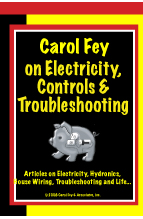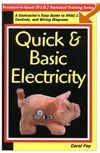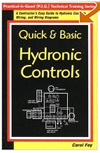by Carol Fey
You could replace a thermostat with a light switch, and the
heating equipment would never know the difference.One day long
ago, when I was newer in this industry than I am now, I was
sitting in the well-appointed office of a large homebuilder.
I was there because the heating contractor had told me that
the reason he was putting in the cheapest (in both meanings
of the word) thermostat was because the builder told him to.
The builder had just told me that he went with whatever the
heating guy recommended.
As I began my pitch, "Well in that case, we can do what's
best for the homeowner ... " he interrupted.
"Stop! The homeowner doesn't care what thermometer's on
the wall."
Thermometer. Thermometer? A thermostat is not a thermometer.
A thermostat is a switch!
That's right. A thermostat is a simple switch. When I teach,
I even have the class repeat, "A thermostat is just a switch.
A thermostat is just a switch." No matter how fancy the
stat, its function is a simple turn-it-on, turn-it-off switch.
You could replace a thermostat with a light switch, and the
heating equipment would never know the difference. (The people
would certainly know the difference. We'll get to that in a
moment.) But when you're thinking about a control circuit, you
can substitute the simplest switch you can imagine into your
thought process in place of the actual thermostat.
I say this because thermostats are greatly misunderstood. Some
folks, such as that builder, think they're much less than they
are. But other folks, such as some in our industry, think they're
much more than they are. In terms of the parts of a circuit,
a thermostat is not a power supply (as in "I know this
stat's no good because it's not putting out any power").
Neither is a thermostat a load (as in "How much power does
that stat pull?").
So as far as what a thermostat does in a circuit, it is either
on, calling for heat (closed switch, letting power through so
the equipment can come on), or is it off, not calling for heat
(open switch, not letting power through to the equipment).Too
Hot, Too Cold
The reason we use a thermostat rather than a wall switch is
to automate the temperature control and to keep the temperature
consistently comfortable.
With a wall switch, someone would have to notice that heat is
needed and flip the switch. By then the room would be too cold.
Then the heat would run until someone realized it was too hot.
The too hot, too cold situation is called temperature swing,
or in every day people terms, "This place is never comfortable."
The switching happens between the screw terminals that are either
on the thermostat or the wall plate that comes with it. The
heating terminals are marked with the industry standard R and
W.
R means "red." A considerate installer will use a
red wire to connect this to one of the transformer terminals.
(Experts say it doesn't really matter which.)
W means "white." The considerate installer will use
a white wire to connect this terminal to the "TH"
(for thermostat) terminal of the load, if the terminals are
marked, as they are in a gas valve or ignition module. If they
aren't marked, as in a zone valve, either one will do.
The R and W thermostat terminals are just like the two screw
terminals on a light switch. The switching action happens between
them, inside where you can't see it. When there's a call for
heat, the thermostat closes the connection between R and W.
If a thermostat has only R and W terminals, it is "heating-only"
or "two-wire." Most thermostats today have at least
four terminals: R, W, Y and G. This is called "heat-cool"
or "four-wire." You can always use just the two heating
terminals of a four-wire stat.
The Y (yellow) terminal is for an air-conditioning compressor,
and the G (green) terminal is to bring a blower up to high speed
for air conditioning. A four-wire stat has three switches inside
it: R-W for heating, R-Y for the compressor, and R-G for the
high-speed fan.
Sometimes an electronic thermostat also has a C terminal. If
the C terminal is present, it must be wired to the transformer
in order to power the clock of a setback thermostat. Other terminals,
such as O and B, are for accessories, and you can ignore them.Comfort
Level
How does the thermostat switch get opened and closed? This is
where automation comes in, even if it's an old-fashioned (read
that as nonelectronic) thermostat.
Bring out your recollection of scientific principles. What does
metal do when it gets colder? Right. It contracts. And of course
it does the opposite, expands, when it gets warmer. Inside the
thermostat is a piece of metal, called a bimetal. It's called
bimetal because it's two (bi = two, as in bicycle = two wheels)
different kinds of metal sandwiched together.
These two metals move at a predictable rate when temperature
changes. In inexpensive snap-action-type thermostats, the movement
of the bimetal itself causes the switching action. These are
inexpensive because it takes many degrees of temperature change
before the heat comes on or off.
The amount of temperature change that happens before the heat
turns on or off is called temperature swing. Less is better.
The industry definition of comfort is that people don't notice
any temperature change in the room at all. It's been found that
for most people that's less than two degrees. Two degrees! That's
not much. Since we're very much in the comfort business, we
need to use a thermostat with a temperature swing of less than
two degrees.
We can still stay within the two-degree temperature range with
an electro-mechanical thermostat, provided a mercury bulb is
added to the bimetal. The bimetal is coiled to about the size
of a quarter. A mercury bulb is fastened on the outside end
of the coil. The thermostat switch is inside the mercury bulb.
Take a look sometime -- you can see the little switch terminals
in there. As the room temperature changes, the bimetal moves,
and that movement causes the mercury to move as the bulb tips.
A cooler temperature causes the bulb to tip so the mercury covers
both terminals of the switch. That "makes" or closes
the switch, which brings the heat on.
That's an explanation of how a thermostat does its switching.
As you might expect, there are several other factors that enter
into doing it well. Folks in the heating business have usually
heard these terms. Most aren't quite sure what they mean or
how to use them.
It turns out they are a very inexpensive, non-time-consuming
way to deliver a top-notch heating comfort system. Some of these
are cycle rate, temperature swing and the anticipator.
All of this brings up the question, "Are we in the emergency
service call business or are we in the comfort business?"
More on that next month. |




